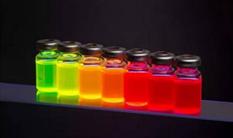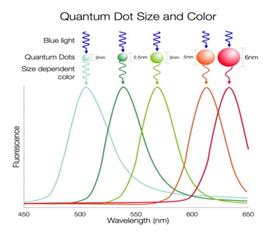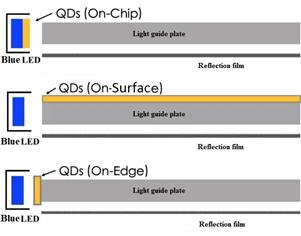Quantum dots and the encapsulation
As a novel nano material, the quantum dots (QDs) has outstanding performance due to its size range. The shape of this material is spherical or quasi-spherical, and the diameter of it range from 2nm to 20nm. QDs has lot of advantages, such as wide excitation spectrum, narrow emission spectrum, large Stokes movement, long fluorescent lifetime and good biocompatibility, especially the emission spectrum of QDs can cover the whole visible light range through changing its size.

Among the diverse QDs luminescent materials, the Ⅱ~Ⅵ QDs included CdSe were applied to widely applications owing to their rapid development. The half-peak width of the Ⅱ~Ⅵ QDs ranges from 30nm to 50nm, which can be lower than 30nm in the appropriate synthesis conditions, and the fluorescence quantum yield of them almost reaches 100%. However, the presence of Cd limited the development of QDs. The Ⅲ~Ⅴ QDs which have no Cd was developed largely, the fluorescence quantum yield of this material is about 70%. The half-peak width of green light InP/ZnS is 40~50 nm, and the red light InP/ZnS is about 55 nm. The property of this material needs to be improved. Recently, the ABX3 perovskites which need not cover the shell structure has attracted a lot of attention. The emission wavelength of them can be adjusted in the in visible light easily. The fluorescence quantum yield of the perovskite is more than 90%, and the half-peak width is approximately 15nm. Because of the color gamut of QDs luminescent materials can up to 140% NTSC, this kind of materials has great applications in luminescent device. The main applications included that instead of rare earth phosphor to emit lights which have a lot of colors and lightting in the thin-film electrodes.


QDs shows the saturated light color owing to this material can obtain the spectrum with any wave length in lighting field, which the half width of wave length is lower than 20nm. The QDs has lot of characteristics, that included adjustable emitting color, narrow emission spectrum, high fluorescence quantum yield. They can be used to optimize the spectrum in LCD backlights and improve the color expressive force and gamut of LCD.
Encapsulation methods of QDs are as follows:
1)On-chip:the traditional fluorescent powder is replaced by QDs luminescent materials, which is the main encapsulation methods of QDs in the lighting field. The advantage of this on chip is few amount of substance, and the disadvantage is the materials must have high stability.
2)On-surface:the structure is mainly used in backlight. The optical film is made of QDs, which is right above LGP in BLU. However, the high cost of large area of optical film limited the extensive applications of this method.
3)On-edge: the QDs materials is encapsulated to strip, and is placed on the side of LED strip and LGP. This method reduced the effects of thermal and optical radiation which are caused by blue LED and QDs luminescent materials. Moreover, the consumption of QDs materials is also decreased.


